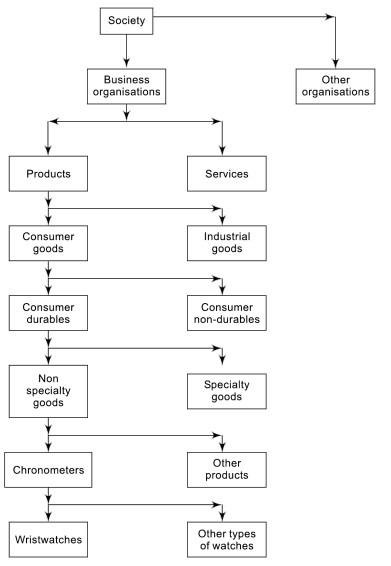Understanding business is vital to defining it and answering the question ‘What is our business?’ It could also be a pointer to the answers to the questions: ‘What will it be?’ and ‘What should it be?’ Mission statements can use the ideas generated through the process of understanding and defining business
Defining Business: A watch manufacturing company may call itself the ‘timekeepers to the nation’. Exhibit illustrates the many options available to a company in the timekeeping business.
Exhibit
Understanding the Business of Timekeeping: An illustrative diagram, like the one shown here, can be helpful in understanding business. In this diagram, we have attempted to relate societal needs to the business of timekeeping. Each successive step provides alternative ways through which the timekeeping needs of the society could be satisfied. Consider the following illustrative examples.
Wristwatches could be of different types, for example, ladies’, men’s, children’s, and sports watches. Ladies’ wristwatches could be either utility or ornamental watches. Other types of watches could be timepieces, wall clocks, and pocket watches.
Other products could be an hourglass or a sundial Specialty watches could be video timers, calculator watches, and car clocks.

Consumer nondurables could be time punching machines and stop watches. Services could be telephone or teletext time services. Other organisations which roughly meet the timekeeping needs could be, for instance, a churchbell chiming at appointed hours, or a call to the faithful from mosques.
All the above options, or their combinations, lead to the satisfaction of the timekeeping needs of a society four other variables are useful in understanding the business of timekeeping.
These are Functions which watch can perform, such as, providing the time, day, date, and direction. Customer needs satisfied by actions like finding time, recording time, using watches as fashionable accessories, and presenting them as gift items.
End usages, like, direct use by customers, and indirect use, as subassemblies in the form of watch and clock movements, by industry. The technology used, based on mechanical, quartz digital or quartz analog manufacturing.
All the above options and variables are, however, relevant to the current ‘state of the art’. The timekeeping business could change radically if a breakthrough occurs any time in the future, For instance, if it could somehow be possible to embed sensors in the human brain that would enable a person to just know and feel the time rather than finding time by looking at a watch, timekeeping could become just another neurological function. The Implications of such a breakthrough for society and business are exciting. Naming just two of these, we could say that visually challenged persons could benefit a lot by such a technological advancement, and the business of timekeeping would never be the same: all timekeeping equipment that we use today could face the risk of becoming redundant. The business of timekeeping, is therefore, certainly not making more, better, sophisticated and a variety of watches but providing the means whatever they might be to simply know the time.
Drawing an example from Exhibit it can be said that a particular company providing only ladies wristwatches of utility and ornamental types using the quartz analog technology could define its business in one way. Another company, a government supplier, may choose to make mechanical wall clocks. Both the companies are in the timekeeping business but they cater to different customer groups, provide different customer functions, and use alternative technologies.

